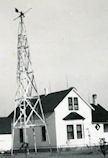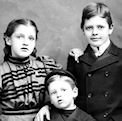
“The building was completely destroyed by fire on October 31, 1947. The fire started about 11:00 p.m. in the projection room after the second show. About 100 people were in the building. Everyone got out unharmed.” (
Opera House, Valley, Neb. from the
Valley Public Library collection)
When we talk to new and prospective participants to the
Nebraska Memories Project, we ask that the images contributed be identified with the basic who, what, where, and when for a general description. But, as we have heard time and again, people especially enjoy the additional stories or information that participating institutions gather about their items. Where does the information come from—the basic as well as extra? Well, participants often use the traditional research tools such as old newspapers, local history books and census records. But many of them also tap into people’s knowledge and memories.
The Valley Public Library, in addition to questioning people individually, organized a coffee and cookies event at the local café. According to Gerri Nordell, invitations were mailed out and transportation arranged to bring in about twenty folks from their homes or the local care facility. Magnifying glasses helped with the small details in photographs, and one person’s memories nudged another’s. After two hours, “they left … still talking about the ‘good old days’.”

In Sidney, people’s memories had already been tapped for a book on local history. But two volunteers in particular who ran the Cheyenne County Historical Society and Museum added extra details when working with Commission staff. In small communities, these older people often know all the local businesses, families and their homes. And the information, as is found in the record’s Historical Notes field for this image (
George and Mabel Jung farm with early wind power from the
Cheyenne County Historical Society and Museum collection), can provide insights into the lives and living conditions of people in Nebraska and the Midwest during those earlier times.

Another volunteer-run project, the
Butler County Gallery collection (which consists mostly of studio portraits), used a different approach in tapping people resources. Whenever they heard a family reunion was to be held, they would reach out to promote their collection and ask for information. Feedback included people’s names, birth and death dates, professions and activities, and personal stories. And, of course, corrections! Such was the case with this photograph of
Lyle, Fay and Garth Osterhout.
So, if your Nebraska institution has Nebraska-related historical materials that others could enjoy, learn from, or contribute stories to, consider becoming a Nebraska Memories participant. The Nebraska Library Commission hosts the database and will work with your staff on selection of appropriate materials, scanning the items and gathering information to create descriptive records. For more information about participating, see
http://nlc.nebraska.gov/nebraskamemories/participation.aspx, or contact
Beth Goble, Government Information Services Director, or
Devra Dragos, Technology & Access Services Director.
Nebraska Memories is a cooperative project to digitize Nebraska-related historical and cultural heritage materials and make them available to researchers of all ages via the Internet. Visit
Nebraska Memories to search for or browse through many more historical images digitized from photographs, negatives, postcards, maps, lantern slides, books and other materials.
 “The building was completely destroyed by fire on October 31, 1947. The fire started about 11:00 p.m. in the projection room after the second show. About 100 people were in the building. Everyone got out unharmed.” (Opera House, Valley, Neb. from the Valley Public Library collection)
When we talk to new and prospective participants to the Nebraska Memories Project, we ask that the images contributed be identified with the basic who, what, where, and when for a general description. But, as we have heard time and again, people especially enjoy the additional stories or information that participating institutions gather about their items. Where does the information come from—the basic as well as extra? Well, participants often use the traditional research tools such as old newspapers, local history books and census records. But many of them also tap into people’s knowledge and memories.
The Valley Public Library, in addition to questioning people individually, organized a coffee and cookies event at the local café. According to Gerri Nordell, invitations were mailed out and transportation arranged to bring in about twenty folks from their homes or the local care facility. Magnifying glasses helped with the small details in photographs, and one person’s memories nudged another’s. After two hours, “they left … still talking about the ‘good old days’.”
“The building was completely destroyed by fire on October 31, 1947. The fire started about 11:00 p.m. in the projection room after the second show. About 100 people were in the building. Everyone got out unharmed.” (Opera House, Valley, Neb. from the Valley Public Library collection)
When we talk to new and prospective participants to the Nebraska Memories Project, we ask that the images contributed be identified with the basic who, what, where, and when for a general description. But, as we have heard time and again, people especially enjoy the additional stories or information that participating institutions gather about their items. Where does the information come from—the basic as well as extra? Well, participants often use the traditional research tools such as old newspapers, local history books and census records. But many of them also tap into people’s knowledge and memories.
The Valley Public Library, in addition to questioning people individually, organized a coffee and cookies event at the local café. According to Gerri Nordell, invitations were mailed out and transportation arranged to bring in about twenty folks from their homes or the local care facility. Magnifying glasses helped with the small details in photographs, and one person’s memories nudged another’s. After two hours, “they left … still talking about the ‘good old days’.”
 In Sidney, people’s memories had already been tapped for a book on local history. But two volunteers in particular who ran the Cheyenne County Historical Society and Museum added extra details when working with Commission staff. In small communities, these older people often know all the local businesses, families and their homes. And the information, as is found in the record’s Historical Notes field for this image (George and Mabel Jung farm with early wind power from the Cheyenne County Historical Society and Museum collection), can provide insights into the lives and living conditions of people in Nebraska and the Midwest during those earlier times.
In Sidney, people’s memories had already been tapped for a book on local history. But two volunteers in particular who ran the Cheyenne County Historical Society and Museum added extra details when working with Commission staff. In small communities, these older people often know all the local businesses, families and their homes. And the information, as is found in the record’s Historical Notes field for this image (George and Mabel Jung farm with early wind power from the Cheyenne County Historical Society and Museum collection), can provide insights into the lives and living conditions of people in Nebraska and the Midwest during those earlier times.
 Another volunteer-run project, the Butler County Gallery collection (which consists mostly of studio portraits), used a different approach in tapping people resources. Whenever they heard a family reunion was to be held, they would reach out to promote their collection and ask for information. Feedback included people’s names, birth and death dates, professions and activities, and personal stories. And, of course, corrections! Such was the case with this photograph of Lyle, Fay and Garth Osterhout.
So, if your Nebraska institution has Nebraska-related historical materials that others could enjoy, learn from, or contribute stories to, consider becoming a Nebraska Memories participant. The Nebraska Library Commission hosts the database and will work with your staff on selection of appropriate materials, scanning the items and gathering information to create descriptive records. For more information about participating, see http://nlc.nebraska.gov/nebraskamemories/participation.aspx, or contact Beth Goble, Government Information Services Director, or Devra Dragos, Technology & Access Services Director.
Nebraska Memories is a cooperative project to digitize Nebraska-related historical and cultural heritage materials and make them available to researchers of all ages via the Internet. Visit Nebraska Memories to search for or browse through many more historical images digitized from photographs, negatives, postcards, maps, lantern slides, books and other materials.
Another volunteer-run project, the Butler County Gallery collection (which consists mostly of studio portraits), used a different approach in tapping people resources. Whenever they heard a family reunion was to be held, they would reach out to promote their collection and ask for information. Feedback included people’s names, birth and death dates, professions and activities, and personal stories. And, of course, corrections! Such was the case with this photograph of Lyle, Fay and Garth Osterhout.
So, if your Nebraska institution has Nebraska-related historical materials that others could enjoy, learn from, or contribute stories to, consider becoming a Nebraska Memories participant. The Nebraska Library Commission hosts the database and will work with your staff on selection of appropriate materials, scanning the items and gathering information to create descriptive records. For more information about participating, see http://nlc.nebraska.gov/nebraskamemories/participation.aspx, or contact Beth Goble, Government Information Services Director, or Devra Dragos, Technology & Access Services Director.
Nebraska Memories is a cooperative project to digitize Nebraska-related historical and cultural heritage materials and make them available to researchers of all ages via the Internet. Visit Nebraska Memories to search for or browse through many more historical images digitized from photographs, negatives, postcards, maps, lantern slides, books and other materials. 
